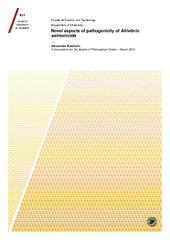| dc.contributor.advisor | Willassen, Nils-Peder | |
| dc.contributor.author | Kashulin, Alexander | |
| dc.date.accessioned | 2018-01-02T10:09:06Z | |
| dc.date.available | 2018-01-02T10:09:06Z | |
| dc.date.issued | 2014-06-19 | |
| dc.description.abstract | Analysis of the fish health reports annually published online by the Norwegian Veterinary Institute (data available starting from 2005), have demonstrated a good epidemiological situation with Cold Water Vibriosis (CWV) in 2005-2010. During this 5 year period only 4 cases were detected in Norway. Starting from 2011 the situation began to change and only during 2011, 5 cases of CWV have been detected in Norway. In 2012 outbreaks of CWV occurred at 21 farms affecting vaccinated Atlantic salmon. In 2013, 13 outbreaks occurred. Regarded as a disease fully controlled by vaccination until 2011, CWV again became a considerable disease in the annual fish health reports. The motivation for this study originated from the hypothetical impact of mobile genetic elements on bacterial adaptation to pathogenicity in other host species than Atlantic salmon and the recent apparent inability of vaccination to provide acceptable protection against CWV. Analysis of nearly 90 research papers dedicated to CWC in 1975-2014 demonstrated a lack of important data on the early dynamics of the disease as well as a lack of clear information on the portal of CWV infection.
The aim of the current project was to fill in the gaps in the knowledge on early dynamics and portal of infection for Cold Water Vibriosis (CWV) as well as to characterize mobile genetic elements potentially driving adaptation of Aliivibrio salmonicida to pathogenicity. During the work on the project we have established a novel in vivo model for evaluation of Cold Water Vibriosis in Atlantic salmon (Salmo salar) and studied the role of different portals for initiation of CWV infection. The obtained results clearly indicated that skin is a major route of CWV infection. The experimental design reported in this study provides a new, rapid and cost-effective model for studying CWV and reveal new previously unknown characteristics of the pathogen. To further demonstrate the universal value of the model we present early dynamics of CWV infection in rainbow trout (Oncorhynchus mykiss) known to be less susceptible to CWV and hypothesize molecular prerequisites for efficient transfer of A. salmonicida into the blood of the two species. Complex analysis of IS elements (Vsa IS) present in the genome of A. salmonicida LFI1238 allowed us to proposed a model of the spread of the Vsa IS elements over the genome of this microorganism. Evaluation of Vsa IS elements allowed us to hypothesize that differential transposition of Vsa IS elements might have an impact on the current epidemiological situation of Cold Water Vibriosis outbreaks caused by A. salmonicida. | en_US |
| dc.description.doctoraltype | ph.d. | en_US |
| dc.description.popularabstract | Hensikten med avhandlingen var å fylle kunnskapshull om tidlig sykdomsmekanisme og om inngangsporten til verten i kaldtvannsvibriose (KV). Det var også et mål å karakterisere mobile genetiske elementer som kan bidra til å gjøre Aliivibrio salmonicida til en mer effektiv patogen. Under arbeidet med denne avhandlingen har vi etablert en ny “in vivo” modell for evaluering av KV i atlantisk laks (Salmo salar), og har undersøkt rollen til de forskjellige potensielle inngangsporter for KV infeksjon. Resultatene fra studien viser klart at hud er en viktig inngangsport for bakterien. Det eksperimentelle designet resulterte i en ny, rask og kostnadseffektiv modell for å studere KV og avslørte nye særtrekk hos patogenen. For å demonstrere modellens universelle verdi presenterer vi tidlig dynamikk i KV hos regnbueørret (Onchorhynchus mykiss). Denne fiskearten er kjent for å være mer resistent mot KV enn atlantisk laks og vi hypotetiserer molekylære forutsetninger for effektiv overføring av A. salmonicida fra sjøvann til blod hos begge arter. Evaluering av disse elementene tillot oss å foreslå at ulike spredningsmønstre av mobile genetiske elementer muligens er knyttet til den nåværende epidemiologiske situasjonen av KV utbrudd forårsaket av A. salmonicida. | en_US |
| dc.description.sponsorship | UiT | en_US |
| dc.description | List of papers:
<p>
Paper I: Kashulin, A., Sørum, H.: “A novel in vivo model for rapid evaluation of Aliivibrio salmonicida infectivity in Atlantic salmon”. Also available in <a href=https://doi.org/10.1016/j.aquaculture.2013.10.025> Aquaculture 2014, 420-421:112-118. </a>
<p>
Paper II: Kashulin, A., Sørum, H.: «Early bacteremia in Atlantic salmon (Salmo salar) and rainbow trout (Oncorhynchus mykiss) during immersion challenge with Aliivibrio (Vibrio) salmonicida”. (Manuscript).
<p>
Paper III: Kashulin, A., Sørum, H., Hjerde, E., Willassen, N. P.: «IS elements in Aliivibrio salmonicida LFI1238: Occurrence, variability and impact on adaptability”. Also available in <a href=https://doi.org/10.1016/j.gene.2014.10.019> Gene 2015, 554(1):40-49. </a> | en_US |
| dc.identifier.isbn | 978-82-8236-141-5 | |
| dc.identifier.uri | https://hdl.handle.net/10037/11887 | |
| dc.language.iso | eng | en_US |
| dc.publisher | UiT Norges arktiske universitet | en_US |
| dc.publisher | UiT The Arctic University of Norway | en_US |
| dc.rights.accessRights | openAccess | en_US |
| dc.rights.holder | Copyright 2014 The Author(s) | |
| dc.rights.uri | https://creativecommons.org/licenses/by-nc-sa/3.0 | en_US |
| dc.rights | Attribution-NonCommercial-ShareAlike 3.0 Unported (CC BY-NC-SA 3.0) | en_US |
| dc.subject | VDP::Mathematics and natural science: 400::Basic biosciences: 470::Molecular biology: 473 | en_US |
| dc.subject | VDP::Matematikk og Naturvitenskap: 400::Basale biofag: 470::Molekylærbiologi: 473 | en_US |
| dc.title | Novel aspects of pathogenicity of Aliivibrio salmonicida | en_US |
| dc.type | Doctoral thesis | en_US |
| dc.type | Doktorgradsavhandling | en_US |


 English
English norsk
norsk
